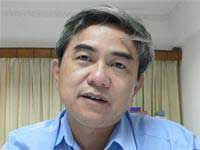Innovative Thinking and Practical Changes in Science and Technology are being developed under the project “Some Policies for the Utilization and Promotion of Science and Technology Personnel, 2006-2010,” drafted by the Ministry of Science and Technology (MoST). The focus is on providing incentives for leading science and technology personnel to create high-quality intellectual products. Mr. NGUYEN QUAN, Director of the Department of Organization and Personnel (MoST), shared his insights with us.
 |
Young Researchers |
– Some scientists often complain about low salaries, which do not provide enough assurance for their contributions. Therefore, the government must have special policies to create better working conditions for them. The MoST proposed to the government that scientists leading national key science and technology tasks should enjoy a special financial mechanism. This is based on the experience of both developed and developing countries in achieving significant accomplishments. There, top scientists receive special policies, high incomes, and substantial autonomy in their research. Hence, this policy is urgent.
* Could you please elaborate on the specific benefits that scientists will receive?
– The government has assigned the MoST one of 21 tasks to develop mechanisms and policies for utilizing and promoting science and technology personnel. This can be considered a reform in the field of science and technology research. It addresses a fundamental issue: the obstacles in financial mechanisms and the creative autonomy of scientists.
According to the draft proposal, the state will provide incentives and support for scientists in two groups.
For the first group, each year, the MoST will research and select 10-20 national key science and technology tasks, then assign them to leading scientists and require these scientists to produce results to hand over to the state. Alongside this, the state will grant scientists autonomy over regular operational funding.
Scientists leading these tasks will have the autonomy to use these funds to increase their income, pay salaries under contracts to collaborators, purchase materials, invite international scientists, register copyrights, publish results in domestic and international journals, and attend international conferences. Additionally, these scientists will be considered for ownership of part or all of the intellectual property generated from state budget resources. At that point, they can use the intellectual property and research results for commercial transactions, transfers, investments, or establishing businesses for production and commerce.
For young scientific personnel, if they have innovative ideas, institutes and universities will establish technology incubation or business incubation groups under the organization, direction, and consultation of a leading scientist.
The state will support funding to help them transform their ideas into research results, produce specific scientific products, or convert research results into commercially viable products through a business’s production activities. Of course, the level of state support for this group will not be as high as that for those undertaking national key science and technology tasks. However, this is a crucial factor in stimulating the emergence of science and technology enterprises.
We anticipate that each year we will introduce several dozen national key science and technology tasks and about 50-60 technology and business incubation groups, with the state investing approximately 100 billion VND for these initiatives.
* How will the income of scientists benefiting from this project compare to that of other scientists?
 | |
Mr. Nguyen Quan |
– If accepted in principle by the Prime Minister, we will coordinate with the Ministry of Finance to develop a specific plan to present to the Prime Minister. It is known that the leadership of the Ministry of Finance also supports this view. We will propose that scientists leading key state scientific and technological tasks receive an income equivalent to approximately 1,000-2,000 USD/month.
Currently, the salary for newly recruited young staff is around 1 million VND/month. Professors directly working at universities earn more, averaging around 5 million VND, including income from teaching, research, and production labor. Scientific staff at research institutes and universities have an average income of no less than 2 million VND. If assigned a key national scientific and technological mission, their income will certainly be much higher.
We estimate that a national task could be allocated regular operational funding of 2.3-2.5 billion VND/year. A research team of about 20-25 people, with such funding, could allow the leaders to earn around 1,000 USD, while others could earn between 100-500 USD. Technology incubation and business incubation groups have lower incomes.
* With such high income levels, what mechanisms will ensure that favored scientists deliver research results, so as not to waste state funds? Given that, in reality, the number of research projects applied in practice has not been many?
– The state sets deadlines and expected results. Scientists must also commit to deadlines and results. Once they accept and commit, they must deliver research outcomes. Those who do not meet deadlines or fail to produce results will face penalties, including the recovery of a significant portion of funding. Projects that fail due to irresponsibility or incompetence must be addressed.
Of course, there are also elements of risk because no one can guarantee that 100% of the assigned tasks will succeed. Science is inherently risky; we believe that achieving results for 50% of 10-20 national tasks is acceptable. Currently, there are thousands of state and ministry-level projects each year, but only about 10% of these can be applied in practice and commercialized.
* So how can we select truly outstanding scientists to participate in executing key national tasks, considering that even in the bidding process for scientific projects, there are still many shortcomings?
– The mechanism will be completely transparent as the number of tasks is not large. First, the state identifies national tasks, then calls for scientists to take on these tasks. Currently, the announcement of the list of projects within the state project system is also a bidding process, but these tasks are not yet of national and international significance, and until now, we have paid little attention to their practical application, allowing anyone to participate in bidding for projects.
However, for tasks required by the government and entitled to special privileges, scientists will certainly have to think very seriously before accepting the assignment. In fact, if no scientist is capable of taking on the task, the state may call for international scientists or temporarily postpone the task; it cannot be assigned to those who are not competent to execute it.
The mechanism for executing tasks is also very different. Currently, state-level projects are often selected through administrative processes, limited within the internal units, making collaboration with other units difficult and lacking the authority to mobilize capable experts from other units to participate.
But for national tasks, the principal investigator has the right to invite scientists from other units to work together if they are deemed capable, and the principal investigator decides their salaries, which are not bound by the usual salary scales… Thus, the collective of scientists is entirely dynamic and proactive.
I believe the challenge is not in identifying the leading scientist for key national scientific and technological tasks, but in correctly identifying the key tasks themselves. Incorrect identification can render the research useless.
* There are concerns that the failure rate will be high because scientists are often only experts in their fields but weak in financial management, yet they will be managing a significant amount of money?
– We will establish a financial mechanism with some standard frameworks for application. For example, it will specify what percentage of the funding should be allocated for personnel, what should be spent on purchasing materials and work tools… This way, the budget for salaries for the principal investigator and collaborators will have a maximum cap, and the principal investigator can only spend within that limit.
The project’s perspective and orientation affirm that investing in people is crucial for the country’s industrialization and modernization, leading to appropriate policies for the utilization and prioritization of each segment within the scientific and technological workforce, promoting the recognition and elevation of scientific and technological staff. The preferential policies and prioritization are linked to the effectiveness of scientific and technological personnel, focusing on the core force of the scientific and technological team to create high-quality intellectual products, timely addressing production needs, and contributing significantly to economic growth.
Some policies in the project may exceed current regulatory limits. Scientists being able to receive high incomes, along with simplified budget payment procedures under a special mechanism… can only be piloted. We plan to conduct a pilot from now until 2010. If successful and yielding good results, we will propose to the National Assembly and the Government to adjust the legal documents accordingly.
KIET HUNG



















































